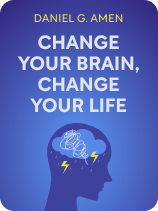

This article is an excerpt from the Shortform book guide to "Change Your Brain, Change Your Life" by Daniel G. Amen. Shortform has the world's best summaries and analyses of books you should be reading.
Like this article? Sign up for a free trial here.
Do you get stuck in negative thought patterns? Do you have compulsive behaviors you’d like to break free from?
Psychiatrist and brain health expert Daniel G. Amen believes that you can change your life if you change your brain. He matches health and psychological problems with brain dysfunctions and offers solutions. He links being stuck in negative thoughts and behaviors with anterior cingulate gyrus dysfunction.
Continue reading to learn how to get unstuck by addressing this part of your brain.
Feeling Stuck?
If you find yourself stuck on negative thoughts or compulsive behaviors, or struggling to adapt to changes in your routine, your anterior cingulate gyrus might be damaged. These symptoms correspond with the traits Dr. Amen describes, including the following:
- Cognitive inflexibility and emotional challenges: excessive worrying, intense emotional reactions to changes or disruptions, difficulty shifting focus or behavior, an inability to recognize alternative solutions, a tendency to hold onto grievances, and perfectionism
- Compulsive behaviors and interactions: obsessive negative thoughts, repetitive behaviors, argumentative tendencies, resistance to cooperation, and addictive behaviors
We’ll look at other potential causes for these symptoms and then turn to Dr. Amen’s advice on how to get unstuck by treating anterior cingulate gyrus dysfunction.
| Various Other Causes for These Symptoms In addition to anterior cingulate gyrus dysfunction, health experts suggest alternative explanations for these symptoms. These explanations shed light on the diverse array of influences that can shape the behavioral complexities Amen describes. Cognitive inflexibility and emotional challenges might arise from generalized anxiety disorder, or mood disorders such as major depressive disorder or bipolar disorder. Compulsive behaviors and interactions can be due to obsessive-compulsive disorder (OCD), post-traumatic stress disorder (PTSD), or sleep disturbances. |
Get Unstuck
Amen’s recommendations for getting unstuck by repairing and optimizing your anterior cingulate gyrus (ACG) region include the following strategies.
Interrupt repetitive thoughts: Recognizing and disrupting repetitive thoughts—for example, by snapping a rubber band on your wrist—trains your ACG to promptly identify and disrupt repetitive thought patterns, enhancing its adaptability.
Distract yourself: Becoming aware of when you’re fixated on a thought and deliberately shifting your focus—for example, by engaging in a different activity—trains your ACG to redirect repetitive thoughts, fostering better control.
(Shortform note: Mental health experts suggest that thought-stopping methods like snapping a rubber band or seeking distractions may offer only temporary relief, as they don’t address the root cause of repetitive thoughts—the issue you’re obsessing over. They suggest you can enhance the effectiveness of these two techniques by pairing them with comprehensive approaches, such as cognitive behavioral therapy or mindfulness, which are aimed at tackling the underlying cause of unwanted thoughts.)
Generate rational solutions: Recording troubling thoughts, formulating actionable steps to address them, and acknowledging aspects beyond your control train your ACG to effectively manage and rationalize repetitive thoughts.
(Shortform note: Tony Robbins (Awaken the Giant Within) offers a practical way to generate solutions—ask yourself three problem-solving questions: 1) What am I willing to do to improve the situation? This question generates specific actions toward resolution. 2) What am I willing to stop doing to improve the situation? This question identifies disempowering habits getting in the way of resolution. 3) How can I enjoy the resolution process? This question encourages you to find pleasure in resolving the cause of your troubling thoughts and motivates you to take immediate action.)
Seek objective advice: Discussing your recurring thoughts or behaviors with others helps you gain impartial insights that enrich your ACG’s problem-solving capabilities and encourage a balanced perspective.
(Shortform note: While discussing concerns with others can yield new perspectives, simply receiving advice may not help you change your thoughts and behaviors. Psychologists suggest that you’re more likely to make positive changes through observational learning—seeing how others successfully manage their thoughts and behaviors. This approach makes the advice more tangible and applicable to your own situations. For instance, if you’re seeking advice on countering stress, you might observe how a friend remains calm and constructive in challenging situations.)

———End of Preview———
Like what you just read? Read the rest of the world's best book summary and analysis of Daniel G. Amen's "Change Your Brain, Change Your Life" at Shortform.
Here's what you'll find in our full Change Your Brain, Change Your Life summary:
- A more effective approach to overcoming physical, mental, and cognitive issues
- The four factors to nurture to improve your brain health
- Why listening to Mozart can enhance your focus and mood control






